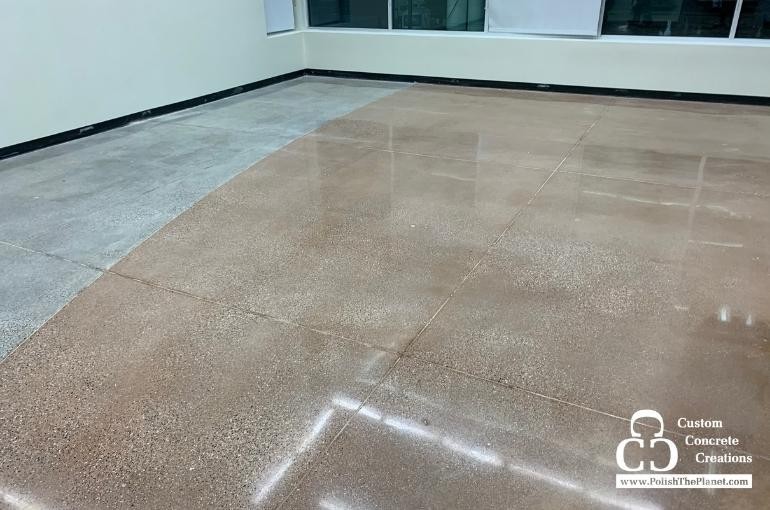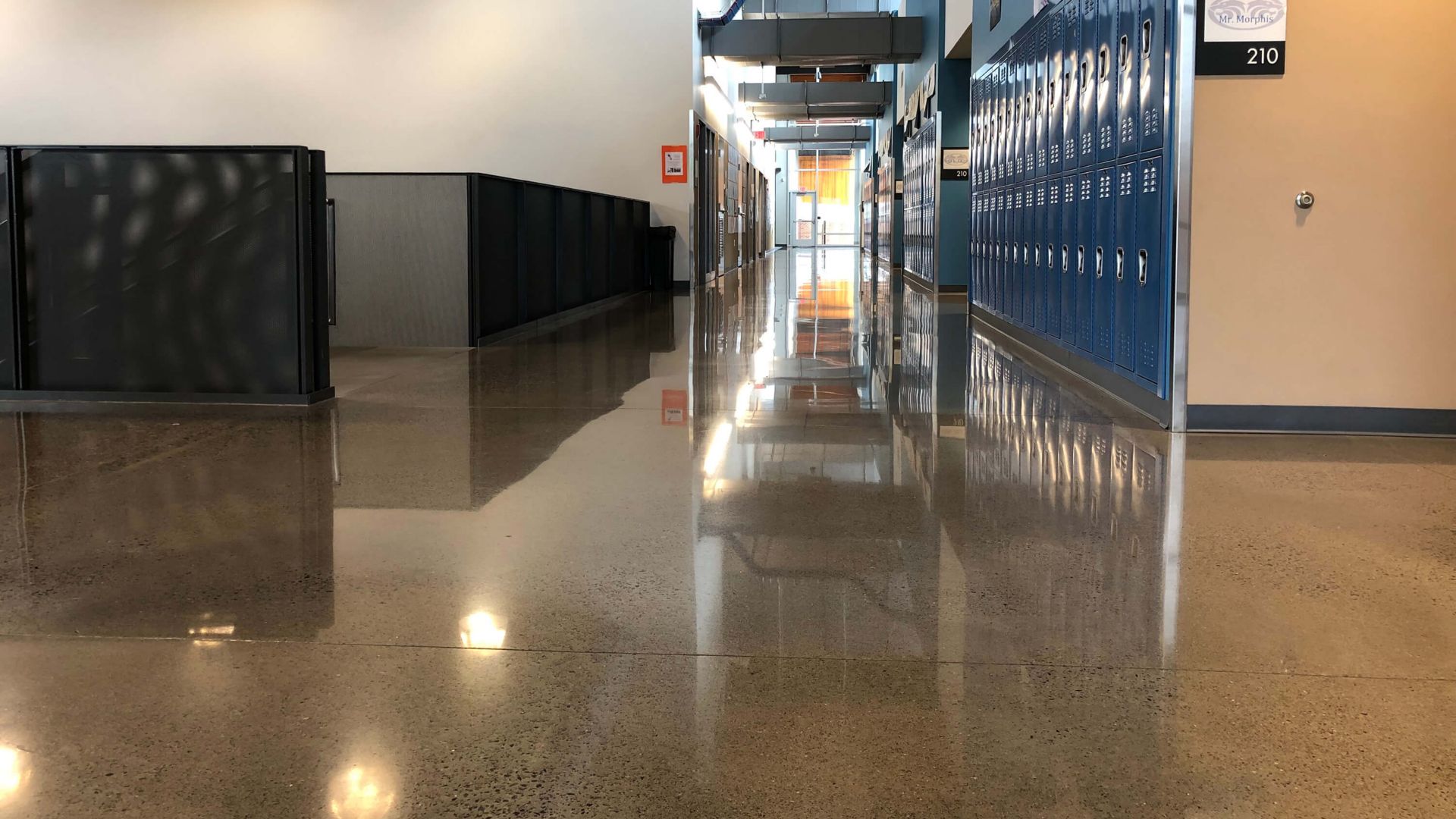FAQs about Polished Concrete Floors Austin
Comprehensive Guide to the Solutions Used in Polished Concrete Flooring Installment
Polished concrete floor covering setup includes numerous vital solutions that add to a long lasting and visually enticing surface. The process starts with thorough surface area prep work, ensuring the concrete slab is tidy and free of flaws. Following this, grinding and honing methods are employed to achieve a smooth surface. The journey does not end there. Understanding the different options for coloring, sealing, and upkeep can considerably affect the last outcome and long life of the flooring.
Surface Area Preparation Methods
Prior to mounting polished concrete flooring, proper surface area prep work is vital to guarantee a sturdy and cosmetically pleasing finish. This initial stage includes numerous critical steps that confirm the substratum appropriates for the overlay. Initially, any existing flooring treatments, such as carpet or floor tile, need to be gotten rid of to reveal the concrete piece. Next, the surface should be completely cleansed to get rid of dirt, oil, and various other impurities that might hinder bond
Additionally, examining the problem of the concrete is important; splits, flaws, and surface area irregularities have to be addressed. This might consist of patching or leveling to produce an uniform base. Wetness testing is likewise recommended, as excess moisture can cause future complications. Using a guide can boost attachment in between the concrete and the polished coating. By complying with these surface area prep work methods, the longevity and appearance of the polished concrete flooring are considerably improved.
Grinding and Sharpening Processes
As soon as the surface prep work is total, the grinding and developing processes play a crucial function in attaining a premium polished concrete coating. Grinding entails using specialized diamond-embedded tools to remove any kind of surface area flaws and achieve a level surface. This process is essential for subjecting the concrete aggregate, which adds to the floor's aesthetic allure.
Honing adheres to grinding and involves finer diamonds to produce a smoother surface. This stage improves the concrete's look and prepares it for succeeding polishing. The grit levels used during honing are very carefully picked to ensure a refined coating without endangering the stability of the concrete.
Both grinding and refining call for experienced drivers who understand the nuances of the concrete surface area and can adjust techniques according to details job demands. Correct execution of these procedures significantly impacts the resilience and aesthetic quality of the final polished concrete flooring.
Brightening Approaches and Equipment
Numerous effective brightening methods and specific equipment are made use of to accomplish a high-gloss coating on concrete floors. One of the most common method includes making use of ruby sprucing up pads, which are readily available in varying grits. These pads are placed on floor polishing equipments that systematically grind the surface to the desired luster.
Wet polishing is favored for its capability to decrease dirt and lower warmth, while dry polishing is favored for its performance in smaller areas. In addition, worldly flooring grinders are commonly utilized as they give even stress and speed, ensuring consistent outcomes.
Advanced tools may consist of automated or remote-controlled machines, which improve efficiency and reduce labor intensity. Ultimately, selecting the appropriate brightening approach and equipment is essential for attaining the wanted finish and resilience of the polished concrete flooring, accommodating both visual choices and practical demands.
Tinting and Staining Alternatives

Tarnishing Techniques Introduction
Exploring numerous discoloration methods can significantly improve the visual charm of polished concrete floor covering. Tarnishing options fall right into 2 key categories: acid-based and water-based discolorations. Acid stains react chemically with the concrete, producing abundant, variegated colors that simulate all-natural stone. They pass through deeply, leading to a resilient surface. In contrast, water-based spots offer a wider spectrum of colors and are less complicated to use, providing an extra uniform appearance. Additionally, concrete dyes can achieve lively tones and are usually made use of together with stains for added deepness. Each strategy can drastically change the visual qualities of the surface, enabling personalization that meets particular design preferences while making certain a distinct, innovative search in any type of room.
Shade Options Available
A varied scheme of color alternatives is available for improving polished concrete floor covering through discoloration and coloring techniques. These approaches enable a variety of hues, from natural tones to vivid tones, providing house owners and services the flexibility to match their visual preferences. Acid-based discolorations react chemically with the concrete, developing a variegated appearance that mimics all-natural stone. On the other hand, water-based spots supply a much more consistent color and are available in a bigger variety of hues - Austin Polished Concrete. Dyes can also be made use of to achieve strong, bright shades, enabling intricate layouts and patterns. Each option contributes to the total effect and longevity of the flooring, making shade selection a vital factor to consider in polished concrete installation
Modification and Effects
While thinking about polished concrete floor covering, modification options for coloring and discoloring play an essential function in attaining unique aesthetics. Property owners and organizations can pick from a varied palette of colors, enabling tailored styles that fit their details preferences and environments. my website Staining techniques, including acid and water-based choices, boost the all-natural beauty of concrete while providing a resilient surface. Acid spots produce rich, variegated colors, while water-based spots supply a more comprehensive variety of shades and are more environmentally friendly. Furthermore, ornamental impacts such as metallic surfaces or color overlays can include deepness and aesthetic passion. This degree of modification warranties that brightened concrete floor covering not just satisfies practical requirements but also complements the total layout vision of the area.
Securing and Safeguarding the Surface
Sealing polished concrete is essential for enhancing durability and preventing damages from spots and wetness. Various kinds of sealants are available, each offering unique advantages and security levels. Recognizing these choices is important for maintaining the honesty and appearance of the flooring.
Relevance of Sealing
The long life and aesthetic charm of polished concrete floor covering significantly depend on the application of a high-quality sealer - Austin Polished Concrete. Sealing offers multiple objectives, mainly protecting the surface area from stains, dampness, and abrasion. By forming an obstacle, sealants protect against the penetration of fluids and chemicals, which can trigger staining and degradation with time. This protective layer additionally enhances the luster and visual depth of the concrete, adding to its general elegance. Additionally, appropriate sealing minimizes upkeep requirements, making it less complicated to clean and keep the floor's appearance. Regularly sealed concrete floorings exhibit enhanced durability, ensuring they hold up against heavy foot web traffic and stand up to wear. Ultimately, securing is an essential step that markedly affects the efficiency and life-span of polished concrete flooring
Kinds of Sealers
Choosing the best sort of sealant is essential for protecting the stability and look of polished concrete floor covering. There are primarily two classifications of sealants: passing through sealants and topical sealants. Penetrating sealers, frequently silicone or silane-based, penetrate the concrete, supplying defense versus moisture and stains while allowing the surface to breathe. On the other hand, topical sealants, such as acrylic or epoxy, produce a safety film on the surface, enhancing gloss and color while offering a barrier against wear and chemicals. Each kind has its benefits; passing through sealants are excellent for high-traffic locations, while topical sealants supply an even more visual coating. Eventually, the option of sealer depends upon the particular requirements and intended use of the polished concrete flooring.
Maintenance and Look After Polished Concrete
Appropriate maintenance and care are vital for expanding the life-span and appeal of polished concrete flooring. Routine cleaning is a primary demand; using a pH-neutral cleaner and a microfiber mop will successfully get rid of dirt and grime without damaging the surface. Prevent making use of extreme chemicals that can boring the coating.

Dusting and sweeping ought to happen often to stop scrapes triggered by debris. Utilizing furniture pads can likewise decrease possible damages from heavy items.
Ultimately, periodic professional upkeep can aid determine any kind of concerns early and anonymous restore the surface area to its original radiance. By sticking to these treatment guidelines, brightened concrete floor covering can stay an appealing and resilient choice for years ahead.
Expense Considerations and Budgeting Tips
While preparing for polished concrete floor covering setup, it's important to assess various price aspects that can impact the total spending plan. The main expenses consist of materials, labor, and any needed site prep work. The kind of finish picked-- such helpful hints as matte, gloss, or ornamental-- also significantly affects expenses. Additionally, the dimension and condition of the room will influence both the amount of concrete required and the intricacy of the setup.
To manage costs efficiently, obtaining numerous quotes from contractors is suggested. This makes it possible for comparisons of services and rates. House owners should additionally consider concealed costs, such as prospective repairs to existing floor covering or the need for specialized tools, which can include in the overall expense.
Establishing aside a backup fund for unanticipated expenses can additionally assure financial preparedness. By taking these budgeting pointers into account, one can achieve a refined concrete flooring that fulfills aesthetic and functional demands without exceeding the budget.
Often Asked Concerns
How much time Does the Entire Installation Process Take?
The setup process duration can vary based upon task dimension and intricacy. Usually, it varies from a couple of days to a week, including surface preparation, grinding, polishing, and sealing stages for optimal lead to polished concrete floor covering.
Can Polished Concrete Be Mounted Outdoors?
Polished concrete can without a doubt be installed outdoors, as it uses longevity and visual allure. Appropriate sealing is vital to secure against weather condition aspects, guaranteeing durability and preserving its visual honesty in exterior atmospheres.
What Kinds of Buildings Appropriate for Polished Concrete?
Polished concrete is ideal for different buildings, including household homes, business rooms, storehouses, and industrial centers. Its longevity and aesthetic allure make it a suitable option for high-traffic areas and environments calling for low upkeep.
Is Polished Concrete Slippery When Wet?
The question of whether brightened concrete becomes unsafe when wet prevails. While it can be glossy, the degree of trickiness commonly depends on the coating and structure applied throughout installation, affecting security in numerous atmospheres.
Can I Set Up Polished Concrete Over Existing Flooring?
The feasibility of setting up polished concrete over existing floor covering depends upon the kind and condition of the underlying surface area. Appropriate analysis and preparation are vital to guarantee attachment and achieve a long lasting, aesthetically pleasing surface.